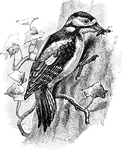Clipart tagged: ‘woody’

British Golden-rod
British Golden-rod is a member of the large composite genus Solidago, which is chiefly North American.…

Root-Grafting
"In the case of large woody plants thus worked the grafted roots, after the operation is completed,…

Shield-Budding
"The simplest and most generally practised form of budding is that called Shield budding or T-budding.…
Suckering Iron
"Root suckers are young shoots from the roots of plants, chiefly woody plants, as may often be seenin…

Great Spotted Woodpecker
A loud bird that uses it beak to bore holes in tree trunks to feed on bugs.

Yucca
"A plant may be operated on wherever the stem has become firm and woody; the top will not fail to make…

